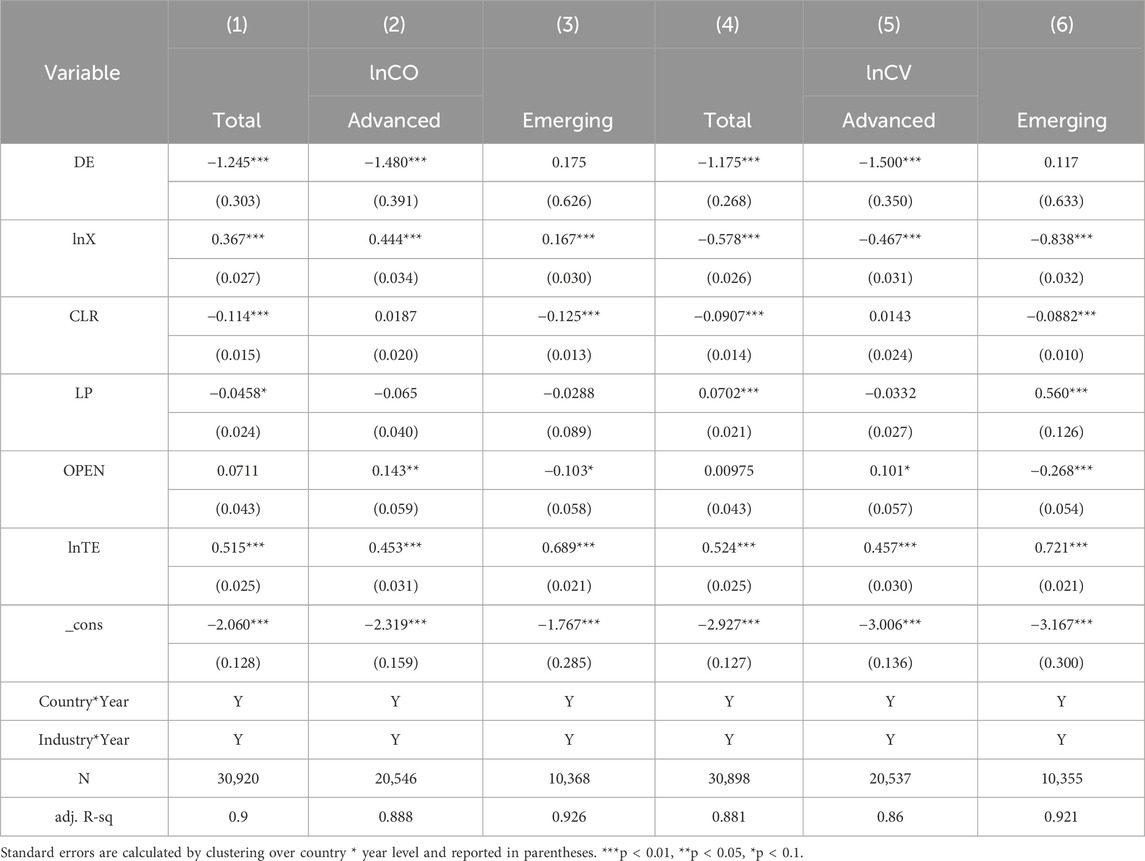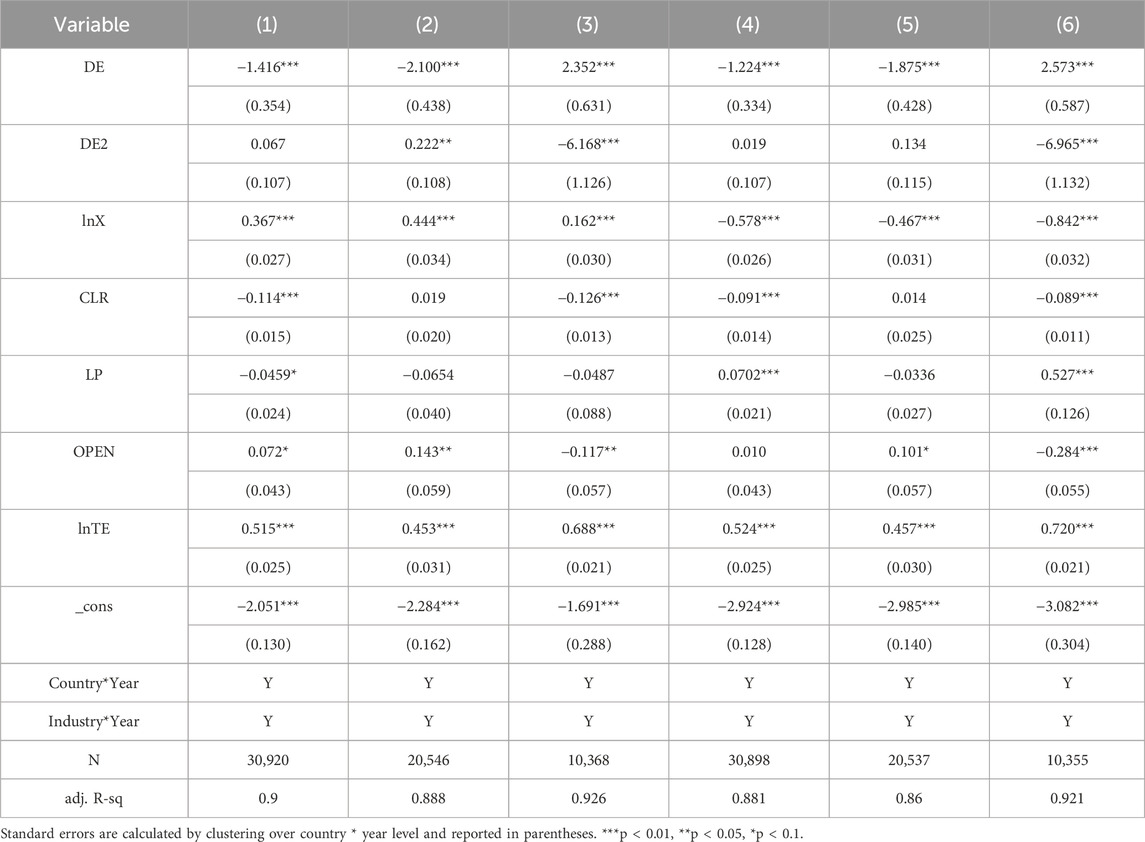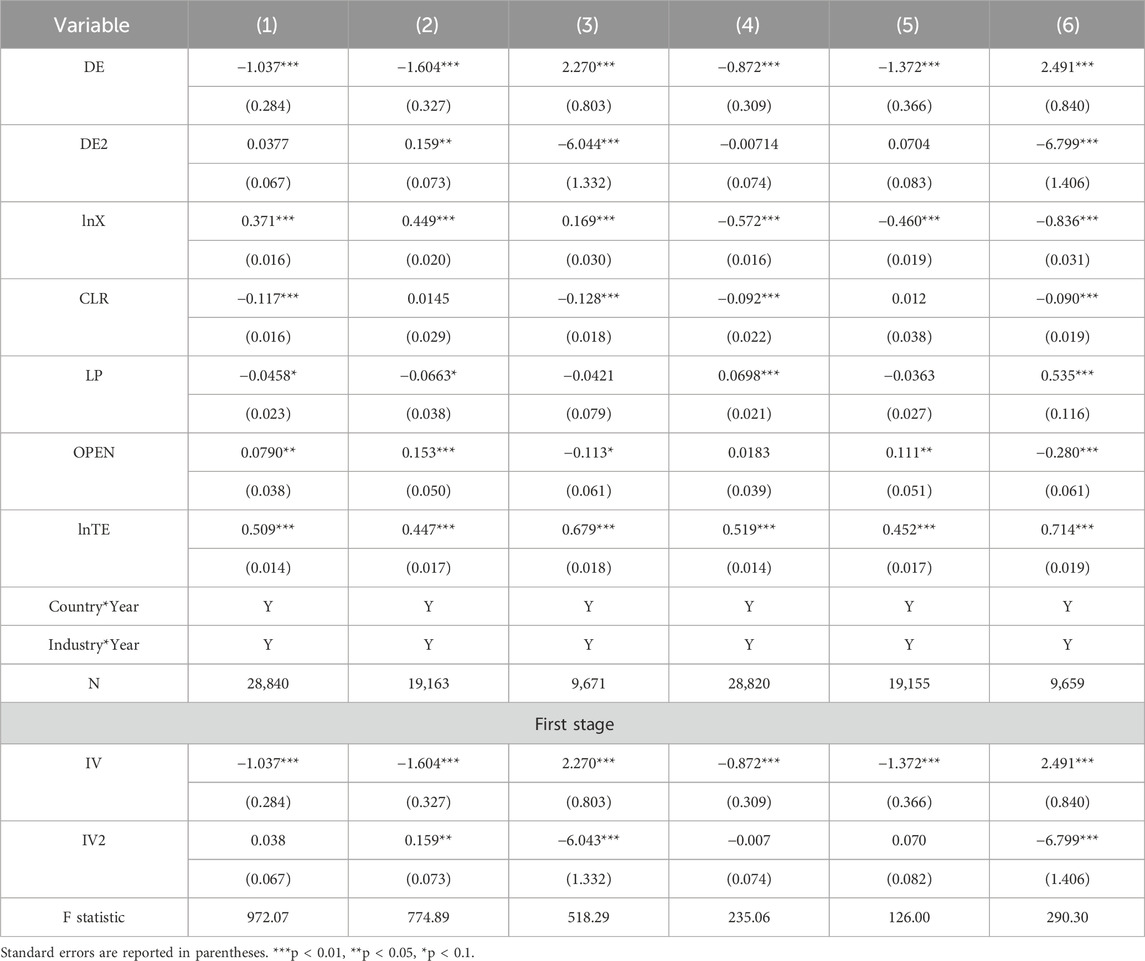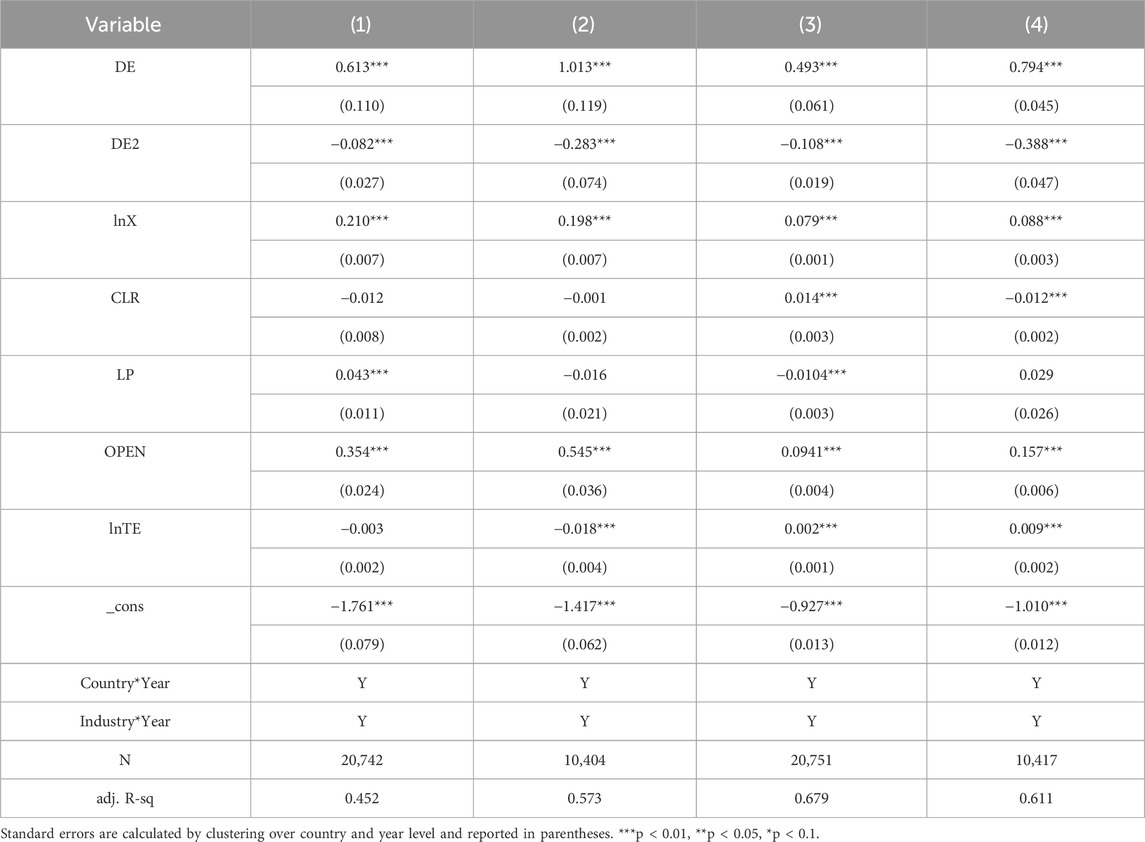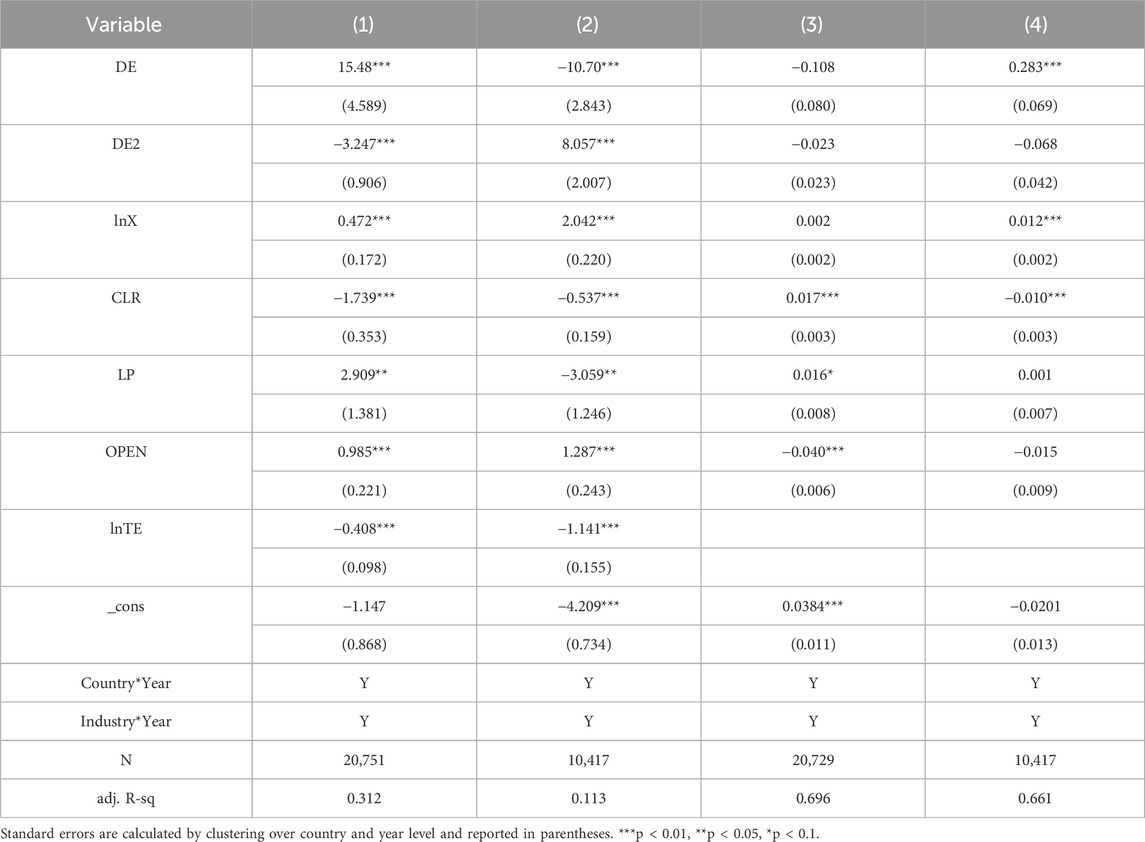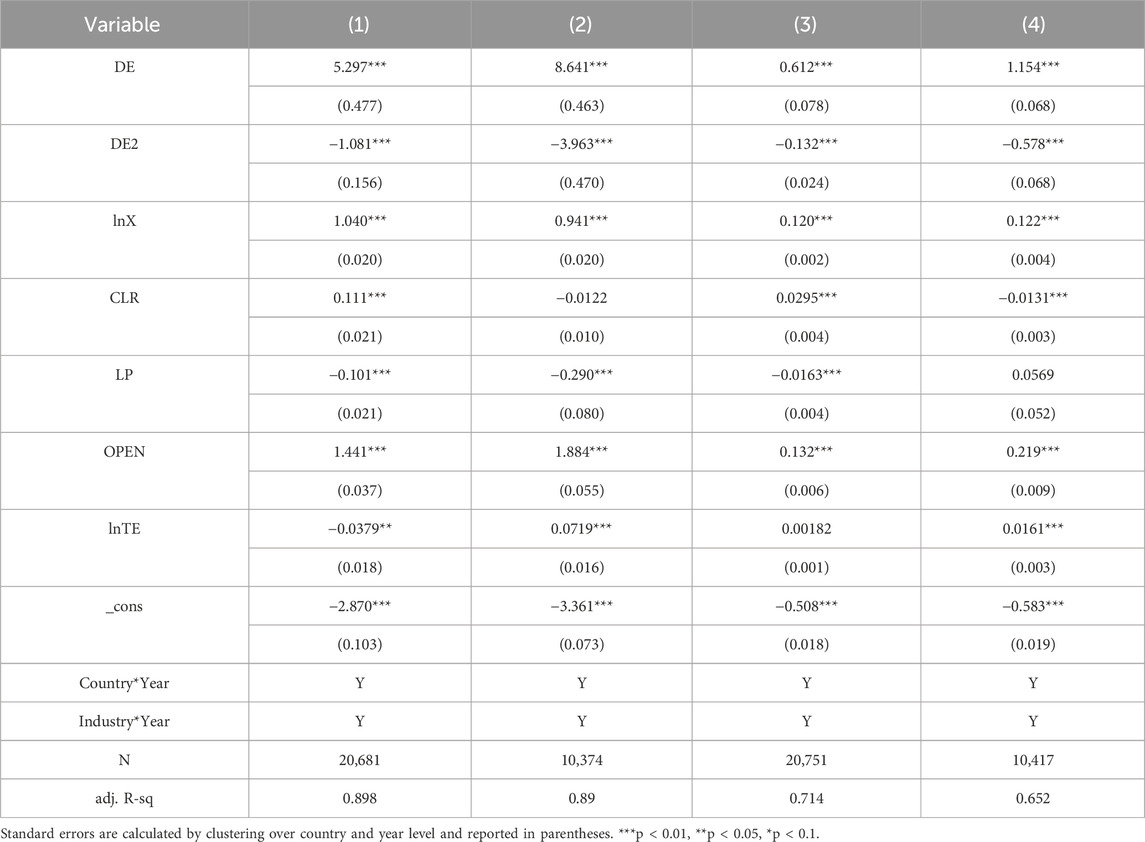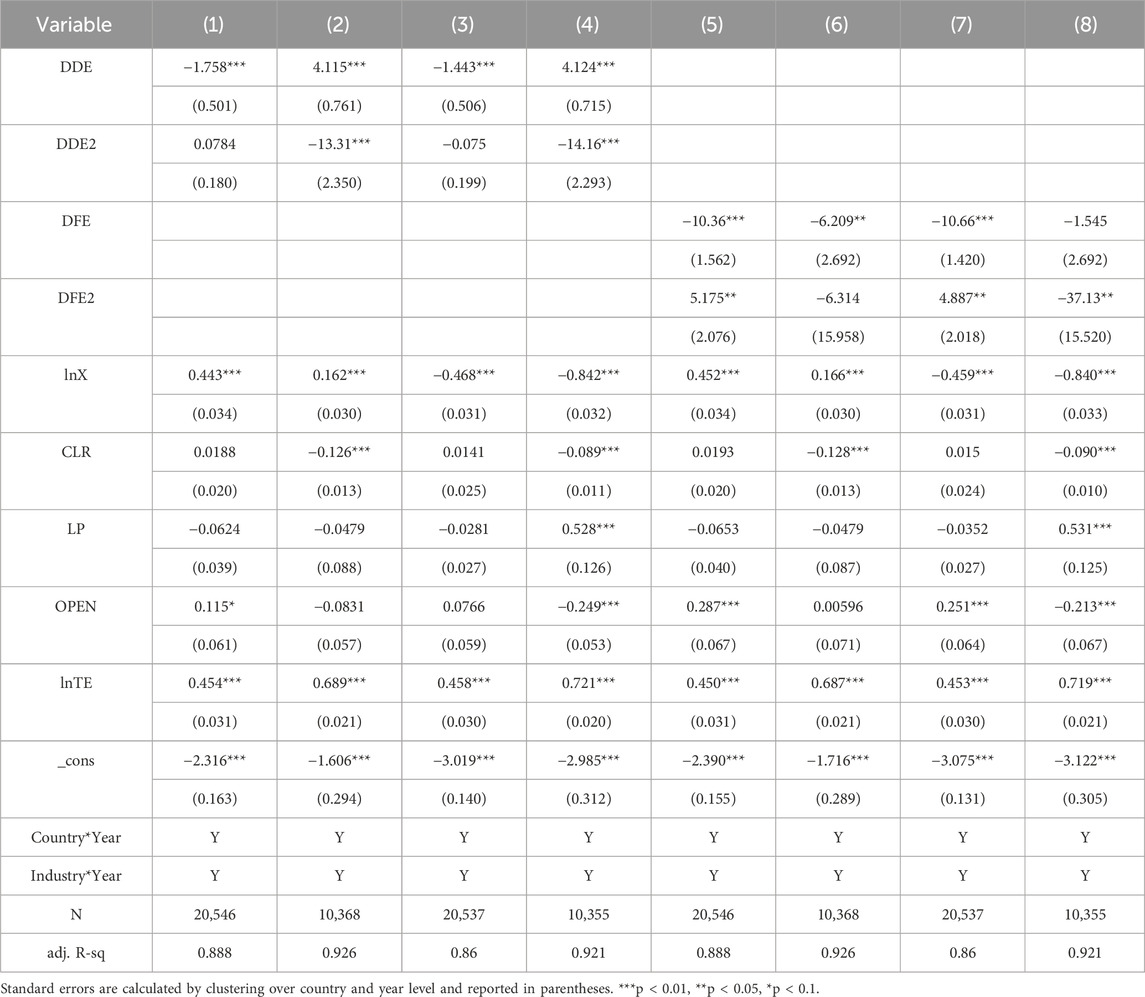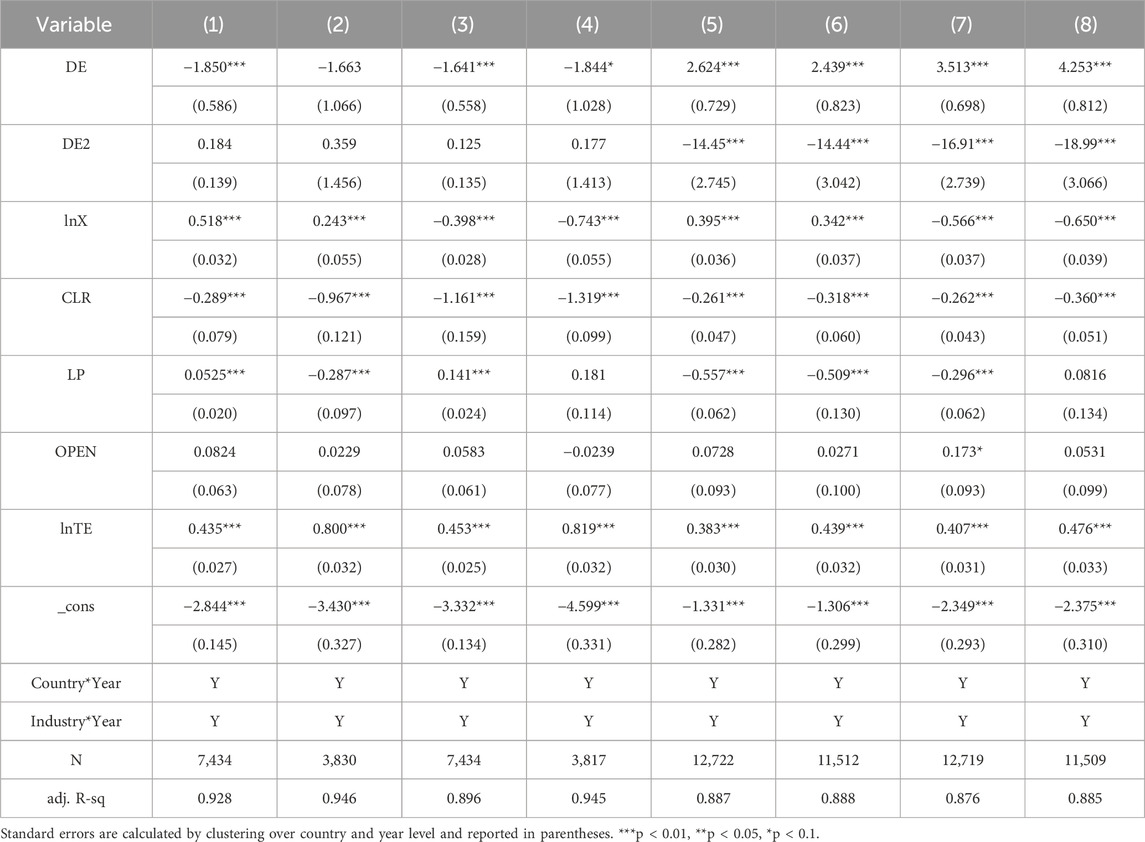- 1Department of Economics, Jiangsu Administration Institute, Nanjing, China
- 2School of Economics, Wuhan University of Technology, Wuhan, China
Digital technologies are increasingly vital catalysts for industrial green transitions, yet their heterogeneous decarbonization impacts across development countries tiers remain underexplored. We pioneer a novel Hypothetical Extraction Method (HEM) to quantify digital empowerment, revealing asymmetric pathways using sectoral data from 43 economies: Advanced economies exhibit a U-shaped trajectory where digitalization initially reduces emissions/intensity but induces rebound effects beyond optimal thresholds, while emerging economies show an inverted U-curve for domestic digital inputs. Mechanistic analyses confirm technology and scale effects universally exist, but structural effects diverge—digitalization raises capital returns in advanced economies yet reinforces coal dependence in developing contexts. Foreign digital sources demonstrate positive environmental returns in emerging economies. Sectorally, digital technologies function as carbon catalysts in manufacturing through automation efficiencies but act as transitional carbon amplifiers in services due to platform-induced energy rebounds. These findings challenge linear decarbonization assumptions and provide empirical foundations for bifurcated digital-climate policies tailored to national development stages.
1 Introduction
The Anthropocene’s climate crisis has entered an acute phase. 2024 witnessed a historic acceleration in atmospheric CO2 accumulation, with annual growth reaching 3.58 ppm - the steepest increase since Mauna Loa records began in 1958 (UKMO, 2024). This alarming trend coincides with the World Meteorological Organization’s confirmation of a 1.55 °C global temperature rise above pre-industrial levels (WMO, 2024), driving systemic biospheric destabilization through intensifying megadroughts, marine heatwaves, and tropical cyclone intensification (IPCC AR6, 2023). As industrial carbon emissions continue outpacing decarbonization efforts—with global CO2 from energy combustion rising 0.8% in 2024 despite COP29 pledges (IEA, 2024)—the paradox of technological progress becomes stark: the economic engine of industrialization now threatens the foundation of civilization, urgently in need of a breakthrough in the green transition.
Amid this crisis, the digital revolution presents a dual-edged sword. Digital technologies are widely recognized for their low-carbon potential and efficiency gains (Wang et al., 2023c), enabling smart manufacturing and AI-driven optimization that are reshaping global industries (Okuyelu and Adaji, 2024). Empirical studies highlight their role in boosting total factor productivity (Cao et al., 2025) and repositioning countries within global value chains (Jin et al., 2024). Yet this optimism obscures a troubling divide: advanced economies are using industrial IoT and blockchain to achieve annual carbon intensity reductions exceeding 5% (OECD, 2024), while emerging economies experience an 18%–22% rise in energy demand due to digital infrastructure expansion (World Bank, 2025). This imbalance exposes not only the flaws in climate-economic models that presume uniform technology adoption but also deep inequities in climate justice, wherein global disparities in digital capacity lead to asymmetrical decarbonization burdens. This imbalance not only reveals inherent limitations in climate-economic models that assume uniform technological diffusion but also accentuates deep-seated disparities in climate justice—where global inequities in digital capacity exacerbate uneven burdens in decarbonization efforts.
Supported by mature digital infrastructures, clean energy systems, and robust policy frameworks, successfully integrate AI, IoT, and blockchain into systematic low-carbon transitions (Jin et al., 2022b; Peng et al., 2024). In contrast, emerging economies face constraints such as carbon-intensive energy structures, digital divides, and limited institutional capacity, which hinder the full realization of digital decarbonization potential (Wang et al., 2022). This divergence underscores the necessity of development-level-specific research. This divergence further highlights the importance of conducting research while distinguishing between different national development levels. Therefore, this article delves deeply into the impact of digital empowerment on industrial carbon efficiency and its underlying mechanisms. In particular, it focuses on the heterogeneity of the carbon reduction effects of digital technologies among countries at different development levels, aiming to assist various countries in effectively utilizing digital technologies to promote carbon emission reduction according to their own characteristics and maximizing the potential of digital technologies.
In conjunction with the existing literature, the prospective contributions of this paper revolve primarily around the following three points: First, we systematically examine the nonlinear relationship between digital transformation and industrial decarbonization across heterogeneous development tiers, employing a dual-lens analysis of both absolute carbon emissions and carbon intensity metrics. While extant research recognizes digitalization as a critical pathway for sustainable industrialization, our work pioneers a comparative framework that disentangles differential technological adoption patterns and environmental outcomes between advanced and emerging economies. The findings provide critical insights for reconciling the apparent paradox between digital leapfrogging and carbon lock-in effects in developing nations.
Second, we develop a novel measurement paradigm using Hypothetical Extraction Method (HEM) to directly quantify digital empowerment, circumventing the measurement bias inherent in conventional composite indices and proxy variables. In addition, using a unique structural evolution perspective, this paper examines the influence mechanism of digital empowerment on industrial decarbonization in countries with different levels of development. The study thoroughly deconstructs the three principal driving mechanisms: factor structure, industrial structure, and energy structure. To the best of our knowledge, this represents the inaugural in-depth exploration of this field from a structural perspective.
Third, we empirically examine the impact of digital empowerment on industrial carbon efficiency using a global dataset covering 56 sectors in 43 major economies from 2000 to 2014. This extensive data set allows us to discern heterogeneous effects across sectors in economies at different stages of development. In doing so, we provide more targeted empirical evidence and insights for policy formulation related to industrial development and environmental protection. This viewpoint not only broadens the spectrum of potential operational strategies for industrial green development but also supplies new evidence supporting the environmental benefits of digital empowerment.
The rest of the paper is organized as follows: Section 2 is devoted to literature review and theoretical analysis. Section 3 constructs empirical specifications and data sources. Empirical results are presented in Section 4. Finally, Section 5 concludes the paper.
2 Literature review, theoretical analysis, and research hypotheses
2.1 Literature review
The rapid advancement of digital technology has transformed economic models and attracted significant scholarly interest. While many studies highlight its economic benefits—such as driving economic growth (Huang et al., 2023), enhancing technological innovation (Wang et al., 2025b), and boosting employment and resilience (Zhang, 2023)—the environmental implications of the digital economy remain contested. Some researchers argue that it supports carbon efficiency and environmental performance (David et al., 2023; Jin et al., 2025). Others, however, point to its high energy consumption and rebound effects that may intensify environmental burdens (Tao et al., 2023). Additional studies suggest a nonlinear relationship, such as an inverted U-shaped curve between digitalization and pollution, export-embodied carbon, and emission intensity (Zheng et al., 2023; Ma et al., 2023; Wang et al., 2023a). Scholars have explored digital empowerment’s role in enhancing industrial carbon efficiency. However, these studies often focus on single countries or sectors, limiting generalizability and overlooking variations across different development levels.
Regarding industrial carbon efficiency, research has identified multiple influencing factors at macro and micro levels. Macro studies focus on energy structure (Yin et al., 2022), green innovation (Chang et al., 2023), market and government dynamics (Liu et al., 2023), and urbanization (Ma and Shi, 2023). Micro-level analyses examine environmental regulation (Wang and Guo, 2024; Meng et al., 2023), green credit (Tian et al., 2022), and corporate green transitions in manufacturing and steel sectors (Tan et al., 2025). For instance, Wang et al. (2025a) show that green bonds emerge as a particularly timely policy instrument for emission reduction, while artificial intelligence is perceived as a more durable and consistent facilitator for progress towards carbon neutrality.
2.2 Theoretical analysis and research hypotheses
Digital technologies, known for high value-added and low-carbon features, play a pivotal role in enhancing industrial carbon efficiency (Li et al., 2019; Jin et al., 2024). They facilitate the development of clean technologies (Zhu and Lan, 2024) and improve governmental monitoring and precision in environmental regulation (Wang and Guo, 2024), thereby encouraging emission reductions. However, digital empowerment may also increase carbon emissions through scale and rebound effects. Expanded production scale raises fossil fuel dependence (Dzwigol et al., 2024), while improved energy efficiency can stimulate greater energy consumption and lower energy prices (Zhou and Liu, 2024), leading to a rebound in overall energy use. Thus, we propose.
Hypothesis 1. Digital empowerment can reduce industrial carbon emissions and intensity, though its benefits may be partly offset by scale expansion and the energy rebound effect.
Cross-country disparities in developmental trajectories, industrial structures, and technological capabilities lead to significant variation in the carbon mitigation efficacy of digital technologies between advanced and emerging economies. This heterogeneous decarbonization outcome is analyzed through three distinct channels: technological effects, structural effects, and scale effects.
Technologically, advanced economies leverage Industry 4.0 to integrate R&D, production, and market systems, advancing frontier innovation and reducing energy intensity via smart manufacturing (Wang and Guo, 2024; Huang et al., 2022). In contrast, emerging economies experience constrained upgrading: digital adoption often optimizes local efficiency but reinforces technological dependence, creating a “digital veneer effect” that locks them into carbon-intensive segments of global value chains (Wei et al., 2024).
Structurally, advanced economies witness high-skill complementarity, with automation shifting investment toward smart infrastructure and renewable-digital synergy. Meanwhile, emerging economies face structural stickiness: digital tools are often co-opted to optimize fossil-based systems, resulting in “high-carbon efficiency traps,” while slow capital-labor substitution prolongs reliance on low-skilled, carbon-intensive activities.
In terms of scale effects, advanced economies internalize high-value digital activities (e.g., carbon data services), boosting domestic value-added and reducing carbon-intensive intermediate trade. Emerging economies use digital platforms to access end-markets directly and streamline supply chains via digital twins, yet often remain dependent on semi-finished imports.
Hypothesis 2. The technological, structural, and scale effects of digital empowerment heterogeneously affect carbon reduction and intensity across advanced and emerging economies.
3 Empirical model design, variable construction, and data sources
3.1 Empirical model design
The main purpose of this paper is to examine the heterogeneous impact of digital empowerment on the industrial carbon efficiency from a global perspective. Based on the above theoretical analysis, the regression model is built as follows:
In Equation 1, the subscripts i, j, and t refer to country, industry and year, respectively; C represents the numerical values of industrial carbon emissions and carbon intensity; DE measures the intensity with which the industry is empowered by the digital industry.
To exclude the influences from other determinants on the final results, referring to the existing literature, we include a vector of sector-level control variables in Equation 1 as follows: (1) Industrial scale (lnX) is represented by the total industrial output value. (2) Capital-labor ratio (CLR) is ratio of the input of capital to the input of labor in production (the proportion of capital per unit of labor. (3) Labor productivity (LP) is a representation of the total output per unit of labor. (4) External dependence (OPEN) is the proportion of export products in the total output. (5) Total factor productivity (TFP) is decomposed by DEA Malmquist productivity method to measure the technical level of the industry.
3.2 Variables construction
3.2.1 Measurement of digital empowerment (DE)
Drawing on the methodology of Los et al. (2016) and applying the “hypothetical extraction” principle, we develop a novel indicator to quantify the enabling effect of the digital economy on industrial sectors. Consider a home country s and a composite region r encompassing all other economies. Let industry i represent digital economy-related activities1, and industry j cover all other sectors. Following Koopman et al. (2014), gross domestic product (GDP) can be expressed as Equation 2:
Here,
To estimate the contribution of digital industry i to the value added of industry j in country s, we construct a counterfactual scenario in which all linkages between industry j and digital industry i are removed, while keeping the rest of the economic structure unchanged (Yan and Tian, 2020). That is, all elements associated with industry i are set to zero. The corresponding counterfactual GDP under this assumption can be derived as Equation 3:
The digital-enabled portion of industry j’s GDP is then defined as the difference between the actual and counterfactual GDP values. To control for scale effects, we express this contribution as a share of total GDP, yielding our digital empowerment (DE) index in Equation 4:
Originally developed to quantify cross-industry linkages at the national level, the HEM has been widely adopted in economic research. Recently, some scholars have extended its application to assess short-term production changes caused by disasters or disruptions. This approach involves hypothetically “removing” a particular industry and estimating the resulting loss in GDP, which reflects the degree of interdependence between that industry and others, thereby indicating its economic importance. Building on this concept, our study adapts HEM to measure the extent to which digital industries empower other sectors (Dietzenbacher et al., 2019). This assumption-based method offers an intuitive and theoretically consistent metric for estimating the value added generated by digital economic activities within a given industry. We define this contribution as “Digital Empowerment” (DE), and express it as a share of total GDP.
3.3 Data sources and statistical description
This study draws on two primary data sources. The first is the 2016 release of the World Input-Output Database (WIOD), which comprises the World Input-Output Table (WIOT) and the Socio-Economic Account (SEA). It covers data from 2000 to 2014 for 43 major economies. The WIOT is used to compute the Digital Empowerment (DE) index, while the SEA provides data for the control variables. The second source is the 2019 WIOD Environmental Accounts, from which data on carbon emissions and energy consumption are obtained. Furthermore, referring to Jin et al., (2022b), 43 economies are classified as advanced economies and emerging economies. Table 1 presents descriptive statistics for the key variables used in the empirical analysis.
The selected timeframe (2000–2014) is highly representative and offers substantial reference value. It corresponds to a critical period during which digital adoption was primarily market-driven, preceding the broad implementation of policy interventions that defined subsequent years. For example, in China—often viewed as representative of rapidly digitizing economies—the years 2005–2015 witnessed explosive growth in the digital economy, whereas the period after 2016 has been marked by deep integration and coordinated policy support. Similar transitions began even earlier in advanced economies. Thus, our data window covers a foundational era of digital expansion, providing a unique opportunity to examine the organic relationship between digital empowerment and industrial decarbonization with greater internal validity.
4 Empirical results
4.1 Baseline regression results
In this section, we report the baseline regression results, which are shown in Table 2. Specifically, columns (1), (2), and (3) respectively represent the results of estimating the impact of digital empowerment on carbon emissions in the cases of the total sample, samples of advanced economies, and samples of emerging economies. Columns (4) to (6) are similar to columns (1) to (3), except that we will replace the explanatory variable with carbon intensity to reflect the impact of the technical dimension. All regressions are clustered to the country*year level.
As shown in columns (1) and (4) of Table 2, at the critical level of 1%, the digital weighting coefficient (DE) is always significantly negative. This indicates that, on the whole, digital empowerment significantly reduces carbon emissions and enhances carbon efficiency. However, when considering the differences in the degree of development, this conclusion is challenged. In the samples of advanced economies in columns (2) and (5), the coefficient of the key variable DE remains negative and highly significant, while in the samples of emerging economies in columns (3) and (6), the coefficient of the key variable DE becomes positive and is not significant. This reveals that digital empowerment does have heterogeneous impacts on carbon emissions and carbon intensity in economies at different levels of development. Therefore, Hypothesis 1 has been well verified.
Furthermore, to examine the nonlinear relationship between digital empowerment and carbon emission reduction, we report the baseline regression results after adding the quadratic term of the key explanatory variable, as shown in Table 3. Among them, columns (1), (2), and (3) respectively represent the nonlinear estimation results of carbon emissions by digital weighting in the cases of the total sample, the sample of advanced economies, and the sample of emerging economies. Columns (4) to (6) are similar to columns (1) to (3). The difference is that we will use carbon intensity instead of the explanatory variable. All returns are concentrated at the country * year level.
As shown in columns (2) and (5) of Table 3, for advanced economies, there is a significant U-shaped relationship between digital empowerment and carbon emissions. This relationship also exists for carbon intensity, but it is not statistically significant. This indicates that digital empowerment has a more direct effect on carbon emission reduction in advanced economies. However, in the samples of emerging economies in columns (2) and (5), there are significant inverted U-shaped relationships between digital empowerment and carbon emissions and carbon intensity. This indicates that in emerging economies, digital empowerment cannot achieve an effective reduction in intensity in the short term. What’s worse, it may lead to an increase in carbon emissions.
It is noteworthy that for advanced economies, the inflection point of the U-shaped curve lies significantly above the current average level of digital empowerment. This finding serves as an important caution: higher levels of digital empowerment are not invariably associated with improved outcomes. Beyond a certain threshold, the environmental benefits resulting from it may begin to diminish. In contrast, certain regions and industries in emerging economies have already surpassed the inflection point of the inverted U-shaped curve, suggesting that the environmental advantages of digital empowerment are starting to materialize. However, most sectors remain on the downward slope of the curve, underscoring the urgency for emerging economies to accelerate digital transformation and advance green industrial upgrading.
4.2 Robustness checks
Considering the potential causal relationship between the core explanatory variable (DE) and the explained variables, carbon emissions and carbon intensity, it may lead to incorrect results (Wang et al., 2023b). In this section, we estimate the model by constructing instrumental variables using the 2SLS estimator. Referring to Huang et al., 2022, we constructed the instrumental variable of digital authorization (represented as DEIV). Specifically, the fixed-line telephone users of each country in 1990 were used as instrumental variables for DE. To explain the variables that might be absorbed by the fixed effect, we cross-multiplied them with DE and conducted an empirical analysis after a period of delay. The results are shown in Table 4.
The first-stage regression shows that the coefficients of the instrumental variables are highly significant, which proves that the instrumental variables are highly correlated with the explanatory variables. Furthermore, the larger Kleibergen-Paap rk Wald F statistic indicates that the instrumental variable is very strong. Compared with the results of nonlinear benchmark regression, it is found that in the samples of advanced economies, there is still a significant U-shaped relationship between the core explanatory variable DE and the explained variables, whether it is carbon emissions or carbon intensity. For emerging economies, there is a significant inverted U-shaped relationship between DE and the explained variable. This further verifies the robustness of the mechanism regression.
4.3 Mechanism analysis
In this section, we empirically test the mechanisms analyzed in Section 2—namely, the technology effect, structural effect, and scale effect—with results presented in Tables 5–7. Specifically, Table 5 examines the impact of digital empowerment on industrial export technology sophistication and global value chain (GVC) position, with odd-numbered columns representing advanced economies and even-numbered columns representing emerging economies (following the same layout in subsequent tables). Table 6 reports the effects on the capital-labor return ratio (CL) and energy structure, while Table 7 presents findings on domestic value-added and its proportion.
The results in Table 5 shows the results of the technological effects of digital empowerment. Digital empowerment exhibits an inverted U-shaped relationship with industrial export sophistication and GVC positioning across all economies. For advanced economies (odd columns), due to the saturation of cutting-edge innovation, the marginal benefit of technological complexity will decrease when the degree of digital empowerment exceeds a certain stage. Emerging economies (in a row) showed an earlier turning point, reflecting limited absorption capacity - digital tools initially enhanced processing efficiency but failed to promote fundamental technological upgrades.
Table 6 shows the capital-labor return ratio (CL) and energy structure responses confirm systematic divergence: Advanced Economies: Digital penetration increases CL while reducing coal dependency, evidencing smart capital substitution and renewable integration. Emerging economies: Counterintuitively, CL decreases with coal share rising, revealing automation’s limited penetration (primarily in labor-intensive sectors) and fossil energy lock-in effects. Mirroring Table 5, Table 7 demonstrates consistent inverted U-shaped dynamics for scale effects in both the magnitude and share of DVA. These findings collectively confirm Hypothesis 2.
4.4 Heterogeneous analysis
This section presents heterogeneity analyses examining differential effects of digital authorization sources and industry types, with results detailed in Tables 8, 9. Table 8 distinguishes between domestic and foreign digital empowerment sources to assess their distinct impacts on industrial decarbonization pathways. Columns (1)–(4) report effects of domestic digital sources, where odd-numbered columns represent advanced economies and even-numbered columns emerging economies. Correspondingly, columns (5)–(8) analyze foreign digital sources under identical specifications.
Three critical patterns emerge: First, advanced economies exhibit statistically significant U-shaped relationships for both domestic and foreign digital sources. This indicates initial carbon reduction benefits diminish beyond optimal thresholds, consistent with diminishing marginal returns to digital inputs. Second, emerging economies demonstrate divergent dynamics: domestic digital sources generate an inverted U-shaped effect on carbon emissions and intensity, whereas foreign sources show a U-shaped pattern—though statistically insignificant at conventional levels. Third, the inflection point for domestic sources in emerging economies occurs at substantially lower digitalization levels compared to advanced economies.
These findings substantiate our core thesis of asymmetric decarbonization. The inverted U-curve for domestic digital adoption in emerging markets reflects institutional absorption constraints, while foreign digital inputs face compatibility barriers that delay positive environmental returns. This bifurcation underscores how digital sovereignty mediates climate-technology synergies—a mechanism obscured in aggregate analyses.
Table 9 maintains identical empirical specifications to Table 8 but examines sectoral heterogeneity. Columns (1)–(4) analyze manufacturing industries, while columns (5)–(8) focus on service sectors. The results reveal two distinct decarbonization models: Manufacturing shows an economic U-shaped relationship between digital empowerment and emission reduction, although statistically insignificant at 1%. On the contrary, the service industry shows a stable inverted U-shaped curve, that is, digital empowerment will lead to an increase in carbon emissions and carbon intensity in the service industry first and then a decrease. This difference highlights the asymmetric departmental impact of digitalization: digital technologies act as carbon catalysts in manufacturing through automation-driven efficiency gains, whereas in services, they function as transitional carbon amplifiers due to rebound effects from platform expansion, with data center energy demand offsetting early efficiency benefits until network optimization matures.
5 Conclusions and policy recommendations
This study pioneers a novel application of the Hypothetical Extraction Method (HEM) to quantify digital empowerment, revealing fundamental asymmetries in decarbonization pathways across 43 economies. We demonstrate digital technologies act as dualistic enablers: while catalyzing industrial green transitions, their impacts diverge sharply across development tiers and sectors. Empirical analyses confirm nonlinear trajectories: advanced economies exhibit U-shaped dynamics, whereas emerging economies show inverted U-curves. Mechanistic analyses confirm technology and scale effects universally exist, but structural effects diverge—digitalization raises capital returns in advanced economies yet reinforces coal dependence in developing contexts. Foreign digital sources demonstrate delayed positive environmental returns in emerging economies. Sectorally, digitalization functions as carbon catalysts in manufacturing through automation efficiencies but becomes transitional amplifiers in services via platform-induced energy rebounds.
To translate these empirical insights into actionable policies, we propose concrete measures tailored to diverse economic contexts. In advanced economies, a digital carbon footprint monitoring system should be established to track emissions in real time and trigger alerts when thresholds are exceeded, thereby mitigating rebound effects. Within the manufacturing sector, policies should encourage the adoption of smart sensors and Industrial Internet of Things (IIoT) technologies to enhance real-time energy management, enable predictive maintenance, and boost efficiency through automation. For data-intensive service sectors—such as finance, platform-based business models, and cloud computing—regulators should enforce stringent energy efficiency standards for data centers, introduce carbon budgets for digital infrastructure, and provide incentives for implementing green algorithms and low-carbon artificial intelligence models. Concurrently, fiscal support should be directed toward energy-efficient digital infrastructure and the accelerated development of next-generation green digital technologies. In emerging economies, priority should be given to building digital infrastructure powered by renewable energy sources. Manufacturing can leverage digitally optimized production lines and automation technologies driven by clean energy to avoid fossil fuel lock-in. In the services sector, emphasis should be placed on expanding green digital services such as shared mobility platforms, smart grid-enabled power distribution, and low-emission telecommunications networks. Policies should further promote the integration of foreign technology with local capacity-building and circular production models. Targeted subsidies for small and medium-sized enterprises (SMEs) can accelerate the adoption of energy-saving technologies. Globally, policymakers must develop Differentiated Carbon Accounting Standards reflecting varied digital responsibility, facilitate technology transfer under the Paris Agreement, and advance sovereignty-sensitive decarbonization frameworks supported by climate finance and technical cooperation.
To guide subsequent scholarly inquiry, we propose a focused research agenda: Future studies should examine the decarbonization implications of post-2015 digital technologies—such as large-scale AI, edge computing, and block chain—using more recent and disaggregated data, especially in underrepresented regions. Research is also needed on the political economy and institutional conditions under which foreign digital adoption leads to positive environmental spillovers, such as environmental regulations, identifying governance factors that circumvent technological dependence. Finally, dynamic modelling incorporating digital sovereignty and global value chain dynamics will be crucial for predicting long-term carbon lock-in risks and late-mover advantages. These recommendations and research priorities directly address the asymmetries identified in this study and provide tangible inputs for evidence-based, digitally informed climate policy across diverse economic contexts.
Data availability statement
The raw data supporting the conclusions of this article will be made available by the authors, without undue reservation.
Author contributions
MY: Investigation, Resources, Supervision, Writing – original draft, Writing – review and editing. BR: Data curation, Writing – original draft. TZ: Investigation, Formal analysis, Writing – original draft. ZJ: Conceptualization, Visualization, Data curation, Writing – original draft, Writing – review and editing.
Funding
The author(s) declare that financial support was received for the research and/or publication of this article. Financial supports from the Jiangsu provincial Federation of philosophy and social sciences (23SYB-085) and National Party Schools of C.P.C. System Principle Research Project (2023DXXTZDDYKT032) are greatly acknowledged.
Conflict of interest
The authors declare that the research was conducted in the absence of any commercial or financial relationships that could be construed as a potential conflict of interest.
Generative AI statement
The author(s) declare that no Generative AI was used in the creation of this manuscript.
Any alternative text (alt text) provided alongside figures in this article has been generated by Frontiers with the support of artificial intelligence and reasonable efforts have been made to ensure accuracy, including review by the authors wherever possible. If you identify any issues, please contact us.
Publisher’s note
All claims expressed in this article are solely those of the authors and do not necessarily represent those of their affiliated organizations, or those of the publisher, the editors and the reviewers. Any product that may be evaluated in this article, or claim that may be made by its manufacturer, is not guaranteed or endorsed by the publisher.
Footnotes
1Based on the WIOD database released in 2016, as mentioned by Jin et al. (2025), the digital economy-related industries in this paper are: Computer, electronic and optical products; Publishing activities; Motion picture, video and television program production, etc. Telecommunications; Computer programming, consultancy and related activities, etc.
References
Cao, Y., Hao, L., Kou, L., Zhou, J., and Zou, L. (2025). Whether, how and when do artificial intelligence technologies improve enterprise total factor productivity? J. Internet Technol. 26 (2), 241–253. doi:10.70003/160792642025032602009
Chang, K., Liu, L., Luo, D., and Xing, K. (2023). The impact of green technology innovation on carbon dioxide emissions: the role of local environmental regulations. J. Environ. Manag. 340, 117990. doi:10.1016/j.jenvman.2023.117990
David, B., Colin, S., Lukas, T., and Stefan, R. (2023). Digital orientation and environmental performance in times of technological change. Technol. Forecast. & Soc. Change, 188. doi:10.1016/j.techfore.2022.122272
Dietzenbacher, E., Van Burken, B., and Kondo, Y. (2019). Hypothetical extractions from a global perspective. Econ. Syst. Res. 31(4): 505–519. doi:10.1080/09535314.2018.1564135
Dzwigol, H., Kwilinski, A., Lyulyov, O., and Pimonenko, T. (2024). Digitalization and energy in attaining sustainable development: impact on energy consumption, energy structure, and energy intensity. Energies 17 (5), 1213. doi:10.3390/en17051213
Huang, G., He, L., and Lin, X. (2022). Robot adoption and energy performance: evidence from Chinese industrial firms. Energy Econ. 107 (107), 105837. doi:10.1016/j.eneco.2022.105837
Huang, Y., Hu, M., Xu, J., and Jin, Z. (2023). Digital transformation and carbon intensity reduction in transportation industry: empirical evidence from a global perspective. J. Environ. Manag. 344, 118541. doi:10.1016/j.jenvman.2023.118541
IEA (2024). World energy outlook 2024. Available online at: https://www.iea.org/reports/world-energy-outlook-2024.
IPCC AR6 (2023). “Intergovernmental panel on climate change (IPCC),” in AR6 synthesis report: climate change 2023.
Jin, Z., Li, Z., and Yang, M. (2022a). Producer services development and manufacturing carbon intensity: evidence from an international perspective. Energy Policy 170, 113253. doi:10.1016/j.enpol.2022.113253
Jin, Z., Wang, J., Yang, M., and Tang, Z. (2022b). The effects of participation in global value chains on energy intensity: evidence from international industry-level decomposition. Energy Strategy Rev. 39: 100780, doi:10.1016/j.esr.2021.100780
Jin, Z., Wang, H., Luo, C., and Guo, C. Y. (2024). The impact of digital transformation on international carbon competitiveness: empirical evidence from manufacturing decomposition. J. Clean. Prod. 443, 141184. doi:10.1016/j.jclepro.2024.141184
Jin, Q., Tian, W., and Jin, Z. (2025). Digital empowerment and trade-embodied carbon intensity: insights from value-added decomposition in services. Humanit. Soc. Sci. Commun. 12 (1), 112–10. doi:10.1057/s41599-025-04418-6
Koopman, R., Wang, Z., and Wei, S. J. (2014). Tracing value-added and double counting in gross exports[J]. Am. Ec. Rev. 104 (2), 459–494.
Li, H., Zhu, X., Chen, J., and Jiang, F. (2019). Environmental regulations, environmental governance efficiency and the green transformation of China's iron and steel enterprises. Ecol. Econ., 165. doi:10.1016/j.ecolecon.2019.106397
Liu, X., Cifuentes-Faura, J., Zhao, S., and Wang, L. (2023). Government environmental attention and carbon emissions governance: firm-Level evidence from China. Econ. Analysis Policy 80, 121–142. doi:10.1016/j.eap.2023.07.016
Los, B., Timmer, M. P., and De Vries, G. J. (2016). Tracing value-added and double counting in gross exports: Comment. Am. Ec. Rev. 106, 1958–1966. doi:10.1257/aer.20140883
Ma, Q., and Shi, F. (2023). New urbanization and high-quality urban and rural development: based on the interactive coupling analysis of industrial green transformation. Ecol. Indic. 156, 111044. doi:10.1016/j.ecolind.2023.111044
Ma, D., Tang, J., and Jiang, X. (2023). Effects of digital global value chain participation on CO2 emissions embodied in digital exports: new evidence from PSTR approach. Energy Econ. 126 (126), 106913. doi:10.1016/j.eneco.2023.106913
Meng, X., Zhang, M., and Zhao, Y. (2023). Environmental regulation and green transition: quasi-natural experiment from China's efforts in sulfur dioxide emissions control. J. Clean. Prod. 434, 139741. doi:10.1016/j.jclepro.2023.139741
OECD (2024). OECD economic outlook. 1. Available online at: https://www.oecd.org/en/publications/oecd-economic-outlook/volume-2024/issue-1_69a0c310-en.html.
Okuyelu, O., and Adaji, O. (2024). AI-driven real-time quality monitoring and process optimization for enhanced manufacturing performance. J. Adv. Math. Comput. Sci. 39 (4), 81–89. doi:10.9734/jamcs/2024/v39i41883
Peng, H. R., Ling, K., and Zhang, Y. J. (2024). The carbon emission reduction effect of digital infrastructure development: evidence from the broadband China policy. J. Clean. Prod. 434, 140060. doi:10.1016/j.jclepro.2023.140060
Tan, W., Yan, E. H., and Yip, W. S. (2025). Go green: how does green Credit policy promote corporate green transformation in China. J. Int. Financial Manag. & Account. 36 (1), 38–67. doi:10.1111/jifm.12218
Tao, M., Stephen, P., Wen, L., Selena Sheng, M., Wang, J., Wang, G., et al. (2023). Appraising the role of the digital economy in global decarbonization: a spatial non-linear perspective on globalization. J. Environ. Manag. 347 (347), 119170. doi:10.1016/j.jenvman.2023.119170
Tian, C., Li, X., Xiao, L., and Zhu, B. (2022). Exploring the impact of green credit policy on green transformation of heavy polluting industries. J. Clean. Prod. 335, 130257. doi:10.1016/j.jclepro.2021.130257
United Kingdom Meteorological Office (UKMO) (2024). Mauna Loa carbon Dioxide forecast for 2025. Available online at: https://www.metoffice.gov.uk/research/climate/seasonal-to-decadal/long-range/forecasts/co2-forecast.
Wang, H., and Guo, J. (2024). New way out of efficiency-equity dilemma: digital technology empowerment for local government environmental governance. Technol. Forecast. Soc. Change 200, 123184. doi:10.1016/j.techfore.2023.123184
Wang, L., Wang, H., Chao, Z., He, Y., Dong, Z., and Wang, S. (2022). Can industrial intellectualization reduce carbon emissions? — empirical evidence from the perspective of carbon total factor productivity in China. Technol. & Forecast. Soc. Change, 184. doi:10.1016/j.techfore.2022.121969
Wang, H., Li, Y., Lin, W., and Wei, W. (2023a). How does digital technology promote carbon emission reduction? Empirical evidence based on e-commerce pilot city policy in China. J. Environ. Manag. 325, 116524. doi:10.1016/j.jenvman.2022.116524
Wang, J., Wang, W., Wu, H., and Liu, Y. (2023b). Exploring the effects of manufacturing servitization on enterprise energy conservation and emissions reduction moderated by digital transformation. Energy Econ. 122 (122), 106706. doi:10.1016/j.eneco.2023.106706
Wang, X., Qin, C., Liu, Y., Tanasescu, C., and Bao, J. (2023c). Emerging enablers of green low-carbon development: do digital economy and open innovation matter? Energy Econ. 127, 107065. doi:10.1016/j.eneco.2023.107065
Wang, X., Safi, A., and Ge, F. (2025a). Towards carbon neutrality: will artificial intelligence and green bond become catalysts? Energy Econ. 148, 108711. doi:10.1016/j.eneco.2025.108711
Wang, X., Wang, K., Xu, B., and Jin, W. (2025b). Digitalisation and technological innovation: panaceas for sustainability? Int. J. Prod. Res. 63, 6071–6088. doi:10.1080/00207543.2025.2468883
Wei, L., Li, W., and Jin, Z. (2024). Global value chains participation and trade-induced carbon inequality: a comparative analysis of developed and developing economies. Ecol. Econ. 220, 108186. doi:10.1016/j.ecolecon.2024.108186
World Bank (2025). Global economic prospects. Available online at: https://www.worldbank.org/en/publication/global-economic-prospects.
Yan, B., and Tian, K. (2020). The impact analysis of industrial relocation on China's GDP and employment: from the perspective of global value chain[J]. China Ind. Econ. (12), 121–139. doi:10.19581/j.cnki.ciejournal.2020.12.006 (In Chinese)
Yin, Q., Wang, Y., Xu, Z., Wan, K., and Wang, D. (2022). Factors influencing green transformation efficiency in China's mineral resource-based cities: method analysis based on IPAT-E and PLS-SEM. J. Clean. Prod. 330, 129783. doi:10.1016/j.jclepro.2021.129783
Zhang, Z. (2023). The impact of the artificial intelligence industry on the number and structure of employments in the digital economy environment. Technol. Forecast. & Soc. Change 197 (197), 122881. doi:10.1016/j.techfore.2023.122881
Zheng, R., Wu, G., Cheng, Y., Liu, H., Wang, Y., and Wang, X. (2023). How does digitalization drive carbon emissions? The inverted U-shaped effect in China. Environ. Impact Assess. Rev. 102, 107203. doi:10.1016/j.eiar.2023.107203
Zhou, Y., and Liu, J. (2024). Advances in emerging digital technologies for energy efficiency and energy integration in smart cities. Energy Build. 315, 114289. doi:10.1016/j.enbuild.2024.114289
Keywords: digital empowerment, carbon emission, carbon intensity, value-addeddecomposition, structural evolution
Citation: Yue M, Ren B, Zhu T and Jin Z (2025) Asymmetric decarbonization in the digital age: divergent pathways of advanced versus emerging economies. Front. Environ. Sci. 13:1659906. doi: 10.3389/fenvs.2025.1659906
Received: 04 July 2025; Accepted: 12 September 2025;
Published: 30 September 2025.
Edited by:
Katundu Imasiku, Georgia Institute of Technology, United StatesReviewed by:
Xiaoqing Wang, Ocean University of China, ChinaDenzel Christopher Makepa, Chinhoyi University of Technology, Zimbabwe
Copyright © 2025 Yue, Ren, Zhu and Jin. This is an open-access article distributed under the terms of the Creative Commons Attribution License (CC BY). The use, distribution or reproduction in other forums is permitted, provided the original author(s) and the copyright owner(s) are credited and that the original publication in this journal is cited, in accordance with accepted academic practice. No use, distribution or reproduction is permitted which does not comply with these terms.
*Correspondence: Zhida Jin, amluemhpZGFAd2h1dC5lZHUuY24=
 Mingyang Yue1
Mingyang Yue1 Zhida Jin
Zhida Jin
